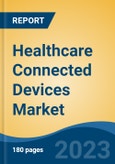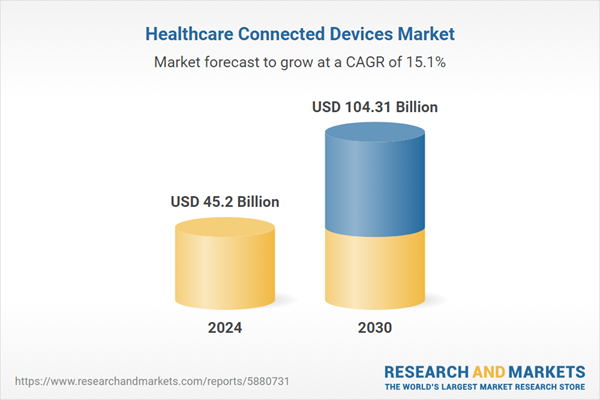Speak directly to the analyst to clarify any post sales queries you may have.
10% Free customizationThis report comes with 10% free customization, enabling you to add data that meets your specific business needs.
By leveraging automated methods, connected healthcare facilitates the connection between patients and caregivers via the Internet, Wi-Fi, and other associated technologies. Not only does connected healthcare offer numerous advantages, but it also has the power to transform the healthcare industry. Through continuous monitoring of vital indicators and the easy accessibility of medical data, connected healthcare promotes patient engagement and satisfaction. By integrating various data sources such as biological, genetic, medical, lifestyle, and sentiment/mood data, patient-centered treatment recommendations can be made based on a comprehensive understanding of a patient's health history and lifestyle.
For instance, according to the Society of Actuaries, 60% of healthcare executives have adopted predictive analytics, with nearly two-thirds expecting at least a 15% cost reduction by 2023. Combining data visualization and predictive modeling helps physicians assess patient risk and optimize resource use, ultimately enhancing care quality and outcomes.
The application of connected healthcare has expanded to include patient education, appointment organization, and medication management, thereby enhancing decision-making and patient satisfaction. The utilization of IoT in healthcare not only contributes to overall cost reduction but also improves medical outcomes. Proactive and preventive care has become a primary focus for hospitals and healthcare facilities, with connected healthcare playing a vital role in early illness detection through continuous monitoring of patients' health statuses. The development of wearable devices for monitoring blood oxygen levels, heart rate, and various biochemical levels in the human body is a testament to the advancements in connected health technology.
Key Market Drivers
Increasing Penetration of The Internet in Healthcare Functions
The internet is utilized in smartphones, tablets, and wearable devices to facilitate the wireless transfer, storage, and display of clinical data. The growing demand for affordable internet access in healthcare operations, coupled with the aim of improving diagnostics, patient experience, and disease management with reduced errors, is driving market growth. For instance, In August 2022, Medtronic partnered with BioIntelliSense for exclusive U.S. hospital and 30-day post-acute home use of the BioButton wearable. This collaboration gave Medtronic access to a medical-grade device offering continuous vital sign monitoring for general care patients, both in-hospital and after discharge.The increasing adoption of wearable technology for precise capture, monitoring, and analysis of physiological data to enhance health and healthcare outcomes is contributing to this growth. The healthcare industry has experienced a remarkable transformation in recent years, driven by the revolutionary impact of IoT technologies and advancements in computer power, data analytics techniques, and wireless technologies. The utilization of Big Data in medical facilities and research sectors has become widespread, enabling the analysis of vast amounts of complex and diverse medical data, encompassing genomics, pharmacogenomics, and proteomics on a global scale.
Traditionally, medical devices and software were primarily utilized for equipment control and data display. However, with the increasing potential of software and its offerings, there is a growing demand for advanced sensory and connected medical hardware equipment. Consequently, the number of connected medical devices is on the rise, accompanied by advancements in software capable of capturing and transmitting medical data, supported by data analytics services. This empowers medical practitioners to derive valuable insights and facilitates the delivery of predictive, personalized, participatory, and preventive healthcare solutions.
Key Market Challenges
Concerns About Data Security
Concerns about data security have posed significant challenges to the growth of the Healthcare Connected Devices market. While IoT-enabled devices offer numerous benefits in healthcare, the collection, transmission, and storage of sensitive patient data through these devices also raise several security and privacy concerns. Healthcare data breaches can lead to the exposure of sensitive patient information, including personal health records and medical histories. Unauthorized access to this data can result in identity theft, fraud, and other malicious activities. The potential for data breaches can deter healthcare organizations from fully embracing IoT devices.IoT devices are susceptible to cyberattacks, such as hacking and malware infections. These attacks can compromise the functionality of devices, disrupt patient care, and compromise the confidentiality and integrity of patient data. Connected healthcare devices often collect a wide range of personal health information, and patients are concerned about how this data is used and shared. The improper handling of patient data can erode patient trust and lead to legal and reputational consequences for healthcare providers and device manufacturers. The lack of standardized security protocols across different IoT devices and platforms can create vulnerabilities. Inconsistent security measures make it difficult to ensure comprehensive protection against potential threats.
Key Market Trends
Increasing Adoption of Home Medical Equipment
As more patients and healthcare providers recognize the benefits of managing health conditions at home, the demand for connected devices that enable remote monitoring, data collection, and telehealth interactions will continue to rise. The aging population prefers to maintain independence and live at home for as long as possible. Connected devices provide a way to monitor the health and safety of elderly individuals while enabling healthcare providers and family members to intervene if needed. Home medical equipment, such as wearable health trackers, smart blood pressure monitors, and glucose meters, can be connected to digital platforms that enable remote patient monitoring.These devices transmit real-time health data to healthcare providers, allowing for timely interventions and adjustments to treatment plans without requiring patients to visit healthcare facilities. As the adoption of home medical equipment continues to grow, the demand for connected devices that enhance remote monitoring, telehealth, and data-driven care will also increase. Manufacturers and developers of Healthcare Connected Devices are likely to invest in innovations that cater to the unique needs of home-based care, ultimately contributing to the expansion and advancement of the Healthcare Connected Devices market.
Key Market Players
- McKesson Corporation
- Medtronic Plc
- GE Healthcare, Inc.
- Omron Healthcare, Inc.
- Draeger Medical Systems, Inc.
- Fitbit, Inc.
- Apple, Inc.
- Microlife Corporation
- Aerotel Medical Systems Ltd.
- Jude Medical, Inc.
Report Scope:
In this report, the Global Healthcare Connected Devices Market has been segmented into the following categories, in addition to the industry trends which have also been detailed below:Healthcare Connected Devices Market, By Product:
- Heart Rate Monitor
- Smart Pill Dispenser
- Portable GPS PERS
- Insulin Pump
- Pulse Oximeter
- ECG Monitoring Devices
- Glucose Monitor
- BP Monitor
- Others
Healthcare Connected Devices Market, By Application:
- Remote Monitoring
- Treatment Services
- Fitness
- Consultation and Diagnosis Services
- Wellness Services
Healthcare Connected Devices Market, By End User:
- Hospitals
- Specialty Clinics
- Home Care Settings/Monitoring
- Ambulatory Surgical Centres
- Others
Healthcare Connected Devices Market, By Region:
- North America
- United States
- Canada
- Mexico
- Europe
- France
- United Kingdom
- Italy
- Germany
- Spain
- Asia-Pacific
- China
- India
- Japan
- Australia
- South Korea
- South America
- Brazil
- Argentina
- Colombia
- Middle East & Africa
- South Africa
- Saudi Arabia
- UAE
Competitive Landscape
Company Profiles: Detailed analysis of the major companies present in the Global Healthcare Connected Devices Market.Available Customizations:
With the given market data, the publisher offers customizations according to a company's specific needs. The following customization options are available for the report.Company Information
- Detailed analysis and profiling of additional market players (up to five).
This product will be delivered within 1-3 business days.
Table of Contents
Companies Mentioned
- McKesson Corporation
- Medtronic Plc
- GE Healthcare, Inc.
- Omron Healthcare, Inc.
- Draeger Medical Systems, Inc.
- Fitbit, Inc.
- Apple, Inc.
- Microlife Corporation
- Aerotel Medical Systems Ltd.
- Jude Medical, Inc.
Table Information
| Report Attribute | Details |
|---|---|
| No. of Pages | 188 |
| Published | August 2025 |
| Forecast Period | 2024 - 2030 |
| Estimated Market Value ( USD | $ 45.2 Billion |
| Forecasted Market Value ( USD | $ 104.31 Billion |
| Compound Annual Growth Rate | 15.1% |
| Regions Covered | Global |
| No. of Companies Mentioned | 10 |









